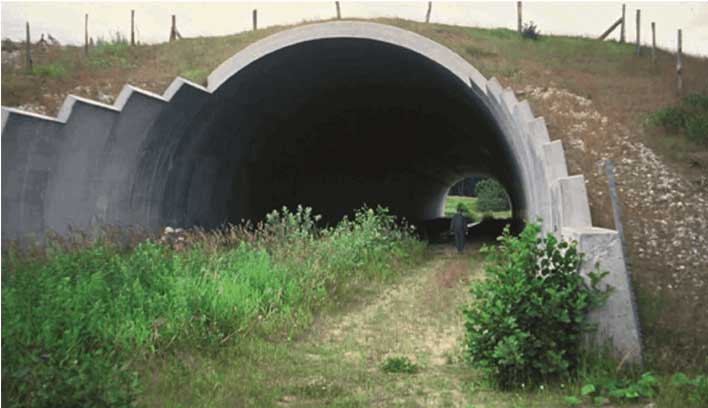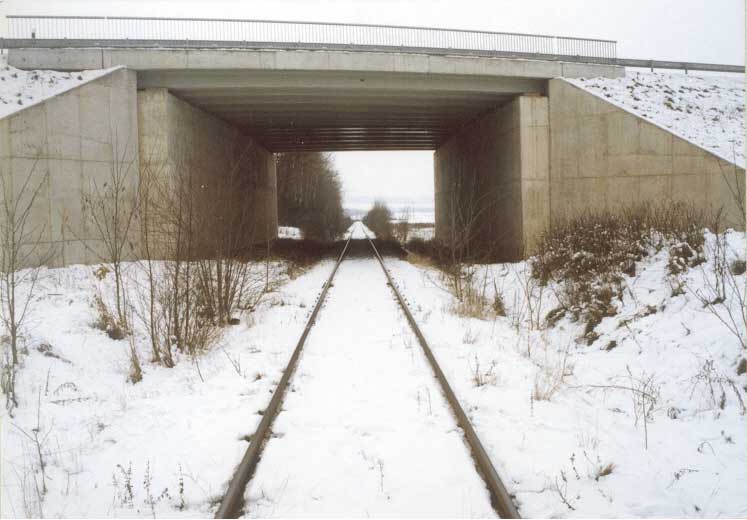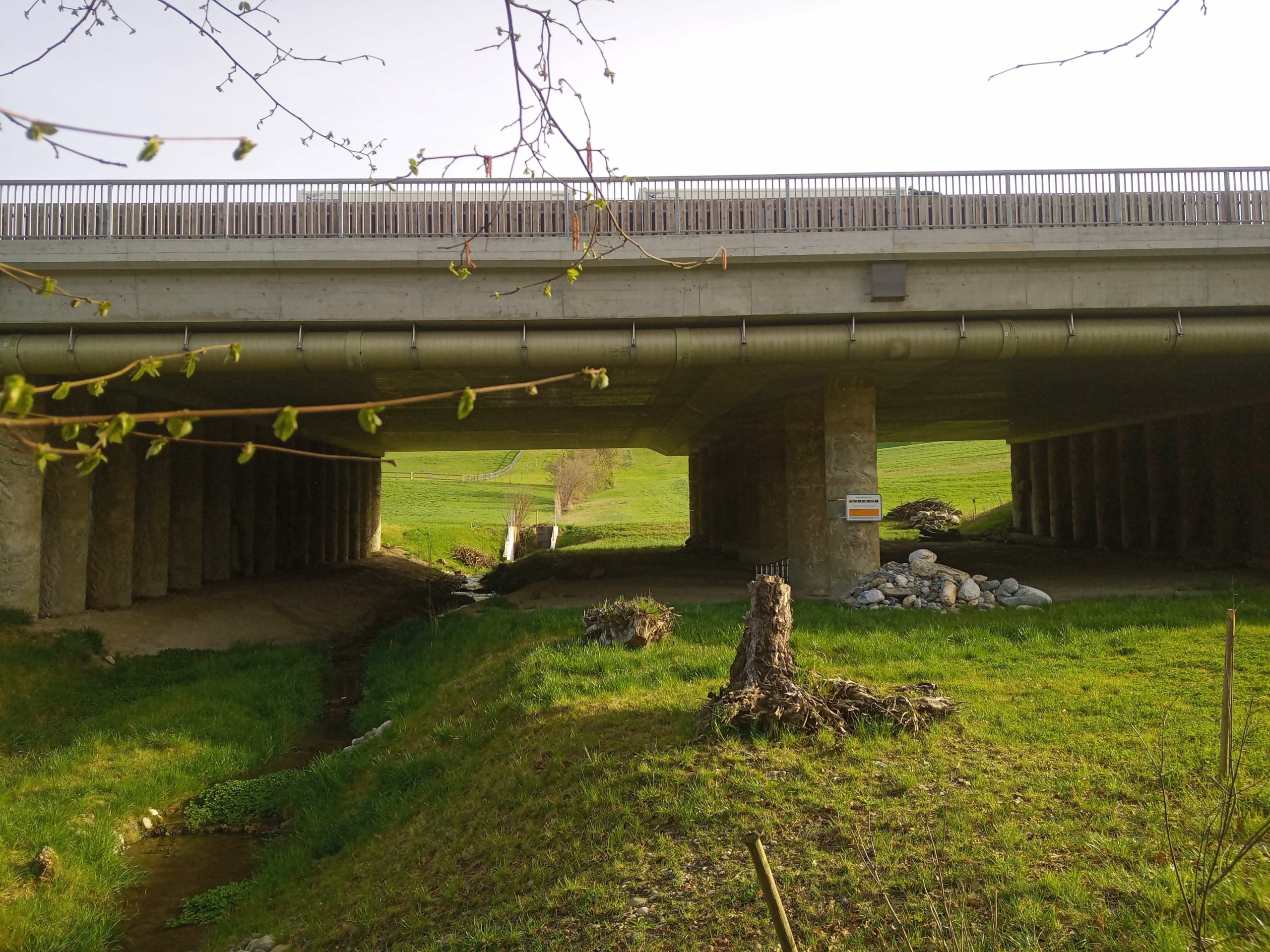General description and targets
Multiuse underpasses are structures built below linear transport infrastructure which combine wildlife use with human use and/or drainage function. In order to classify a passage as a ‘multiuse underpass’ it must meet the structural requirements of the target species, be located in a suitable and accessible environment and be provided with appropriate, specific maintenance to guarantee its long term functionality. Many of the features and requirements mentioned in Section 5.5.7 – Wildlife underpasses are also applicable to multiuse underpasses.
Small forestry roads, cattle passages or pedestrian paths may be compatible with fauna use when appropriate landscaping is provided. A drainage function including streams or other small waterways inside the structure is also compatible and may even lead fauna through the passage.
Due to their high numbers, they may contribute significantly to reducing the barrier effect of infrastructure on wildlife, but multiuse underpasses can never substitute for passages that are specifically designed for fauna and are free of human disturbance, having the potential to be used by a wider diversity of species.
Dimensions and landscaping determine the diversity of species that will use the structure. With joint use, particularly involving traffic, the potential for disturbance is higher, which could mean that species less tolerant of traffic noise and light will be deterred from using it.
When planning new infrastructure, any underpass located in a suitable area should be considered for adaptation to combine drainage and human uses with wildlife passage improving the global permeability of the infrastructure. In all important areas for ecological connectivity underpasses could be provided with appropriate landscaping, fencing and even made wider than required just for drainage or human use.
Existing underpasses may be retrofitted and upgraded to improve the permeability of infrastructure under operation. The many pre-existing underpasses, if suitably adapted, could bring beneficial effects for ecological connectivity.
Design
- The recommended minimum dimensions for multiuse underpasses in European standards ranges from 10 to 20 m width; 3 to 4 m height; 1.5 Openness Index (Table 5.3). Other requirements for ungulates and large carnivores are provided in Table 5.3.
- A minimum width of 10 m is recommended when existing underpasses are being adapted for wildlife use, with at least half of the section for natural soil and vegetation and the remainder for trails or small roads (Table 5.3). In passageslocated in important areas for ecological connectivity a minimum width of 20 m is recommended.
- Underpasses that include streams are particularly suitable for improvement (Figure 5.5.37).
- If a natural stream is included in the underpass, continuity for both terrestrial and aquatic habitats should be provided and riverbanks restored. In long passages lack of light in the central parts of the underpass could limit terrestrial habitat restoration, therefore in important areas for ecological connectivity, viaducts provide the best alternative for restoring habitat continuity.
- Earth-covered strips must be provided at each side of the infrastructure to improve use by fauna.
- Providing shelter inside the underpass (tree stumps, stone rows, heaps of branches, etc.) is recommended for wide structures to offer refuges for small fauna. These elements can be placed on the strips at each side of the passage.
- Underpass entrances may have to be redesigned to facilitate the use of the passage and its integration in the surroundings. Vegetation on both sides of the structure lead animals to the entrance.
- Screens to reduce noise and visual disturbance from traffic circulating over the structure must be installed on both sides of the infrastructure above.
Fencing to guide fauna to the entrances of the passage must be installed with fence ends appropriately connected to walls on both sides of the underpass (Figure 5.2.2). Design and specifications are given in detail in Section 5.2 – Fencing.
Human co-use
- Adaptation of an underpass to enhance its use by wildlife is recommended only when traffic intensity is low; e.g. small roads with less than 500 vehicles per day, even if thresholds must be adapted considering local conditions. Unpaved dirt or gravel tracks are preferred as such surfaces may allow the movements of both small and large wildlife. A ban on vehicle circulation, temporary road closure or limited access to certain vehicle types (e.g., tractors, bicycles) are additional options to be considered (Figure 5.5.35 and Figure 5.5.36).
- Underpasses modified to enhance wildlife should be kept dark at night, avoiding artificial lighting.
- Information panels about wildlife use of the passage could be provided to promote an appropriate use by people and to reduce human disturbance.
- Access for people at night or during certain seasons critical to wildlife movements could be restricted.
- Where conflicts between human and animal use arise and the passage is in a critical location for ecological connectivity, the provision of a separate passage for pedestrians or vehicles is recommended.


